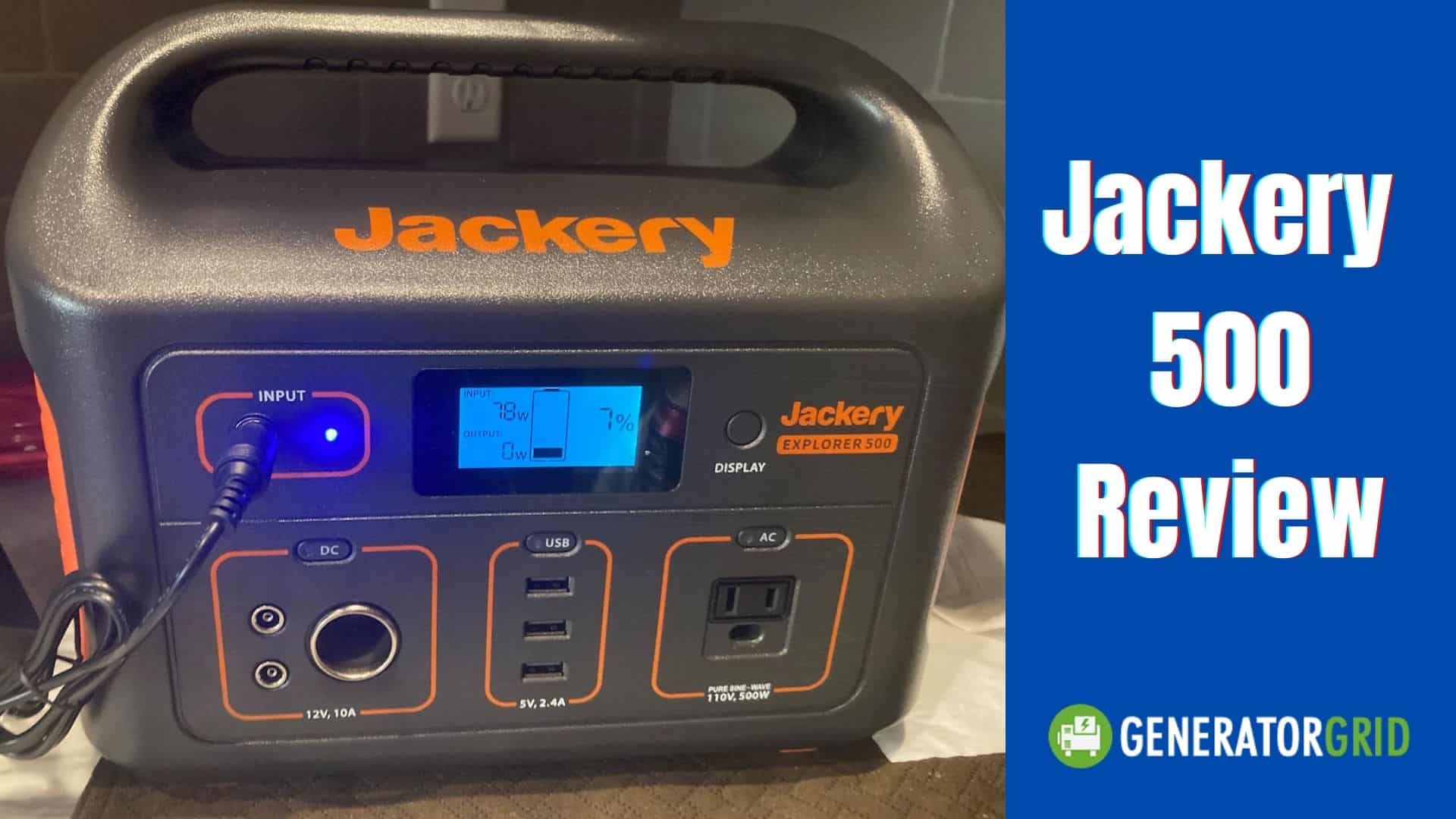Last Updated on August 16, 2023 by Rod Olivares

Electronic goods play such a big role in our lives that when left without them, we can feel a bit lost and uneasy. That’s why emergency power supplies, such as the Jackery Explorer 500, are fantastic to have for the times you need electricity away from home.
This lightweight and portable power station has the capacity for charging a laptop or phone battery, powering a radio, mini-fridge, hairdryer, and more. It is perfect for camping trips, long drives on the road, tailgating, and beach days. The ability to charge through solar panels takes away the stress of needing to find an electricity port on your trip.
Even if you’re not particularly an outdoorsy person, the Jackery 500 is a useful item to have in your home, for when you need a versatile power supply, or for power outages.
If you’re considering getting yourself a 500-watt range portable power station, then keep reading to get in-depth information about this handy portable device.
Jackery 500 Unboxing
In my unboxing video of my Jackery 500 I also bring out my Jackery 1000 to compare size and weights in a real-time first impression:
Jackery 500 Specifications
A product is only as good as its functions, features, and specifications! In this section, we’ll break down all the juicy details about this power station.
- Weight: This power station is light, weighing 13.3 lbs.
- Size: With dimensions of 11.8 (L) x 7.6 (W) x 9.2 (D) inches, the Jackery Explorer 500 is compact for its capacity class, making it easy to carry around or store away after use. I can easily pick it up with one arm.
- Battery: This lithium power station has a battery capacity of 518Wh and a very strong battery life. While stored, it has a lifespan of 3-6 months before it’s time to recharge.
- Ports: The Jackery 500 features 3 USB ports, an AC outlet, and a DC carport. This means you’ll be able to have multiple devices charging at once.
- LCD Display: With the LCD screen, you’ll have a clear understanding of the battery life status and the charge/discharge data. It shows how many Watts are being put into the device when charging (input) and how many out going out when discharging (output).
- Safety: This Jackery portable power station is safe by design with a built-in battery management system (BMS). This helps to protect the rechargeable battery by managing temperature, voltage control, and allowing short circuit protection.
- Warranty: Jackery offers a 30-day money-back guarantee as well as a 2-year warranty on the Explorer 500 portable power station.
- Additional Features: To further ensure safety and effective control over this portable power station, there is a switch light feature that indicates whether the device is on or off for output port charging.
What Can You Power with It?
The Jackery Explorer 500 isn’t a power station that you will be running large electronic devices on constantly, that’s not what it is for. But you can power almost any small electric appliance through it. So, for devices that need charging, or appliances that need power from a few minutes to a few hours, the Explorer is a great guy for the job.
Below you can see some of the items that you can power with the Jackery Explorer 500, and roughly how many times you can do so within each charge:
- Laptops – 7+ times
- Smartphones – 34+ times
- Mini fridges – 8+ hours
- USB small fan – 40+ hours
- Cameras – 60+ times
- Drones – 6+ times
These are just a few examples of popular items you can charge a range of other small-scale electrical appliances including CPAP machines, projectors, and RV ceiling fans and lights.
It’s worth noting that the input power of your devices should be no more than 500W and that the Explorer 500 power is limited to 1000W Peak and 500W Continuous.
Jackery Explorer 500 Against Its Competitors
Most, if not all, products on the market have competition, no matter how good the product is. This holds true for the Jackery 500 as well. To get an idea of what’s out there, it’s useful to look at some other similar products and how the Jackery Explorer 500 portable power station compares. It’s only then that you’ll be able to compare products, consequently, leading you to the best one.
Goal Zero Yeti 400 vs Jackery 500


The Goal Zero Yeti 400 and the Jackery Explorer 500 are almost exactly the same prices. It is a strong contender with 7 output ports, meaning you can power 7 devices at once. The wattage is slightly lower on the Goal Zero Yeti, which means the battery life will be slightly shorter than the Explorer 500 power station.
The Goal Zero Yeti 400 also has a solar panel option, which makes it a green power solution, like the Jackery, and also quiet when working. Something that does put Goal Zero down is its weight. The power station weighs in at 5 more pounds than the Jackery.
You can charge Goal Zero through seven different methods, which works in favor of versatility. You can do this through a wall charger, car charger, and through varying solar panel options including the Nomad 28 Plus and the Boulder 50. There are only 3 ways to charge the Jackery Explorer, which can take around 7.5-9.5 hours. The Goal Zero Yeti 400 can take anywhere between 5-32 hours, depending on your charging method.
SUAOKI G500 vs Jackery 500


There’s something about the aesthetic of the SUAOKI G500 that is enviously sleek, which may appeal to some over Jackery’s more toolbox appearance. The SUAOKI is more expensive, at nearly $50 more. Apart from the higher price and more classy appearance, the Jackery Explorer 500 portable is similar to this lithium battery portable charger.
You can charge the SUAOKI three ways, and the battery life is around 7-8 hours when charged in the wall or car, which is slightly less than the Jackery model. Whilst the SUAOKI isn’t incredibly heavy, it does weigh 2 more pounds than the Jackery Explorer 500 portable power.
In terms of the number of ports, the SUAOKI triumphs over the Jackery having 2 AC outlet ports and 2 DC outlet ports, which can be useful when camping with a group of people. What’s also quite desirable with the G500 is its maximum power point tracking function (MPPT) which converts energy from the solar panel in an efficient way. This can help shorten charging time.
Jackery 300 vs 500
If you want to compare to another, newer Jackery model, check out the 300. It doesn’t have the capacity of the 500, our pure output wattage-wise, but its a great little option, and I prefer it to the 500:
Bottom Line
The SUOAKI G500 and the Goal Zero Yeti 400 are both good power packs and compare closely with the Jackery Explorer 500. There are definitely some perks of the Jackery over the other two like price and weight, but it really depends on what you want out of an outdoor portable power station. There are dozens of options to choose from circling the market. One thing we know for sure, the Jackery Explorer 500 is well worth the purchase!
Pros
- 500W Power: The strong power rating is high enough to ensure you will be able to charge several small devices all at once.
- Eco-Friendly: The solar panel option is great for endless power when outdoors. Not to mention it’s great for the environment!
- Portable & Compact: This solar power portable station is lighter than others on the market making it easy to transport.
- LCD Display: An LCD screen is useful for keeping track of battery life.
- Wallet-Friendly: It’s a decent price for what you get.
- Noise Level: The station is quiet when generating electricity compared to power stations that are not solar powered.
Cons
- There could be more output ports, especially when compared with similar models.
- If you need to power something over 500W, this isn’t for you.
What Are the Reviews Saying?
On Amazon, the Jackery Explorer 500 portable has 4.8 out of 5 stars, and that is from 1,515 reviews. If you ask me, that’s pretty impressive. On the Jackery website the power station has 4.5 out of 5 stars, but only 10 reviews. If you explore the web, it proves difficult to find any negative reviews about this portable power station.
The Final Verdict: Good, not great
The previous line says it all; there’s not much to criticize with the Jackery Explorer 500. This lithium battery power station doesn’t just excel over gasoline and propane generators but leaves the tough competition for other solar-powered generators on the market. The option for solar panels means you can have fume-free electricity which creates no noise pollution either.
The remarkably lightweight design of the 500 portable power is perfect for every scenario, meaning bringing your power pack out with you won’t be a nuisance. You might argue that the Explorer 500 could do with another pure sine AC or DC output, but at the respectable price of under $500, 5 seems generous.
The Jackery Explorer 500 can provide next to limitless power and enables a sense of comfort and freedom when venturing the great outdoors. If you want to stay connected, stay mobile, and keep powered up then the Explorer 500 can help you.
Jackery 500 vs Jackery 300 vs Jackery Explorer 1000
I will say, of the Jackery Explorer line, the 500, while a value for its capacity, is one of my least favorite Jackery products. The Jackery 1000, while significantly heavier, is not that much larger but offers much higher capacity, and also a 60-Watt USB-C output.
The Jackery 500 is an older model than the 1000 or the new Jackery 300. I would recommend those two newer models before the 500 unless you really need the 518 Wh for a specific capacity purpose. If you can get by with less, go with the 300. If you could use more, splurge on the Jackery 1000. It’s a fantastic solar generator and well worth its higher price.

Scott Krager purchased generatorgrid.com in the summer of 2020 and quickly began to buy every generator under the sun! He currently has over a dozen generators and the number is growing quickly. He lives in Portland, OR near his family and friends.
GeneratorGrid.com is an independent review business. I am not affiliated with any manufacturers and do not accept paid reviews. When you buy through my links, I may earn a commission which helps me purchase more generators for testing. - Scott Krager

